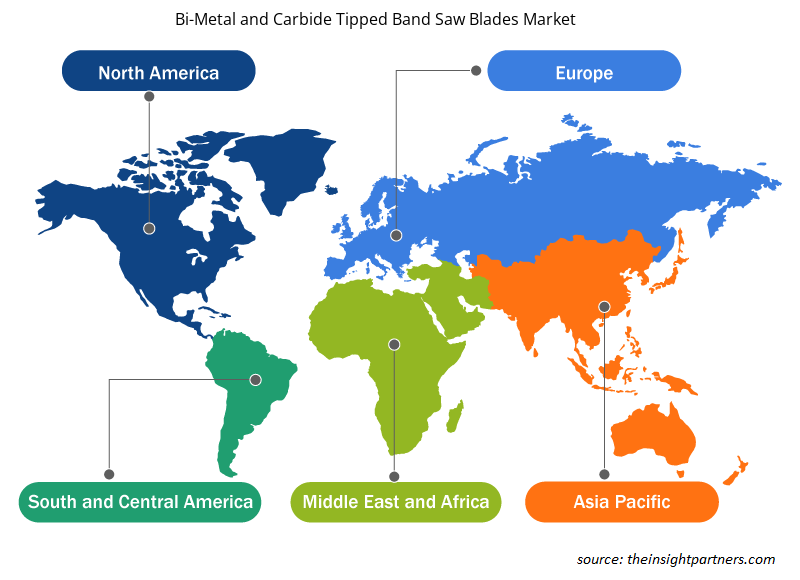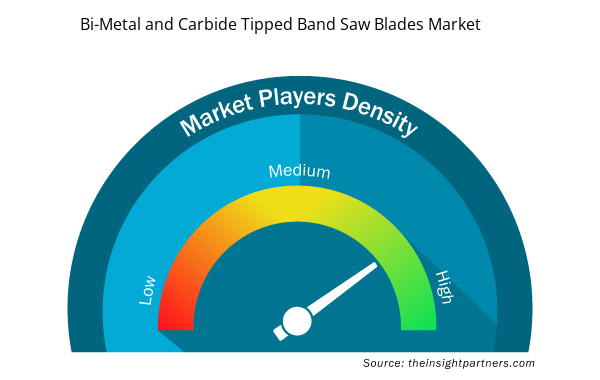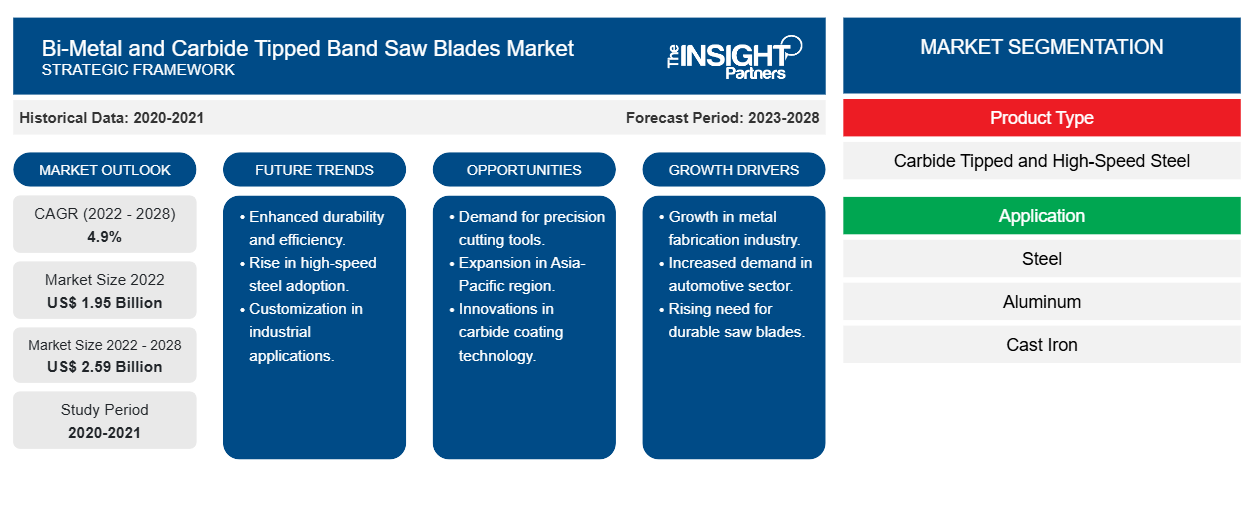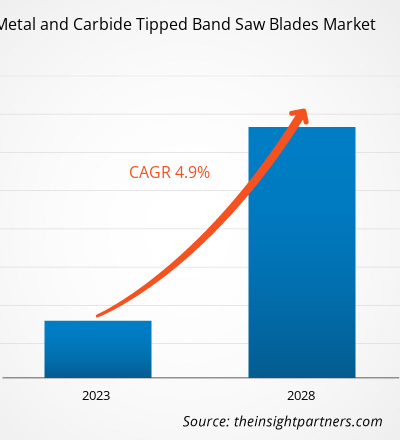Der Markt für Bandsägeblätter mit Bimetall- und Hartmetallspitze wurde im Jahr 2022 auf 1.948,56 Millionen US-Dollar geschätzt und soll bis 2028 2.589,57 Millionen US-Dollar erreichen; von 2022 bis 2028 wird mit einer durchschnittlichen jährlichen Wachstumsrate von 4,9 % gerechnet.CAGR of 4.9% from 2022 to 2028.
Bimetall- und hartmetallbestückte Bandsägeblätter werden hauptsächlich aus hochfestem Stahl (HSS) und Federstahl hergestellt. Diese kostengünstigen Blätter bieten eine hohe Schnittleistung bei hohen Geschwindigkeiten, liefern eine hohe Leistung und bewältigen Herausforderungen im Zusammenhang mit der Produktionseffizienz. Darüber hinaus bieten Bimetall- und hartmetallbestückte Bandsägeblätter eine bessere Schnittleistung, längere Standzeit, überlegene Verschleißfestigkeit und hervorragende Schneidkantenstabilität.
Im Jahr 2022 hielt der asiatisch-pazifische Raum den größten Anteil am Markt für Bimetall- und Hartmetall-Bandsägeblätter , und die Region wird im Prognosezeitraum voraussichtlich die höchste durchschnittliche jährliche Wachstumsrate verzeichnen. Die Verwendung von Bimetall- und Hartmetall-Bandsägeblättern hat in Branchen wie der Automobilindustrie, der Luft- und Raumfahrt, dem Militär und dem Maschinenbau in der Region zugenommen. Darüber hinaus treiben expandierende Bauprojekte und die steigende Automobilproduktion die Nachfrage nach Bimetall- und Hartmetall-Bandsägeblättern an. Diese Blätter werden zum Schneiden von Hartmetallen wie Baustahl, Gusseisen und Nichteisenmetallen bei der Herstellung von Automobilkomponenten und Ersatzteilen verwendet. Infolgedessen wird erwartet, dass der Markt für Bimetall- und Hartmetall-Bandsägeblätter im asiatisch-pazifischen Raum im Prognosezeitraum mit der florierenden Automobilproduktion in der Region wachsen wird.
Passen Sie diesen Bericht Ihren Anforderungen an
Sie erhalten kostenlos individuelle Anpassungen an jedem Bericht, einschließlich Teilen dieses Berichts oder einer Analyse auf Länderebene, eines Excel-Datenpakets sowie tolle Angebote und Rabatte für Start-ups und Universitäten.
- Holen Sie sich die wichtigsten Markttrends aus diesem Bericht.Dieses KOSTENLOSE Beispiel umfasst eine Datenanalyse von Markttrends bis hin zu Schätzungen und Prognosen.
Auswirkungen der COVID-19-Pandemie auf den Markt für Bimetall- und Hartmetall-Bandsägeblätter
Während der COVID-19-Pandemie erlitt der Markt für Bimetall-Bandsägeblätter einen Abschwung aufgrund der unzureichenden Versorgung mit Rohstoffen wie Schnellarbeitsstahl-Zahnspitzen und legiertem Stahl sowie Störungen in den Produktionsprozessen für Bimetall-Bandsägeblätter. Diese Blätter werden in großem Umfang in Stahlanwendungen in mehreren Endverbrauchsindustrien wie der Automobil- und Maschinenbauproduktion eingesetzt. Laut einer Umfrage der Organisation der Vereinten Nationen für industrielle Entwicklung (UNIDO) wurde die Produktion von Bimetall- und Hartmetall-Bandsägeblättern in Indien nach der Einführung eines Lockdowns im Jahr 2020 eingestellt. Kraftfahrzeuge, Metalle, chemische Produkte, Textilien sowie Maschinen und Ausrüstung gehörten zu den am stärksten betroffenen Branchen, die einen Rückgang der Produktion verzeichneten. Die COVID-19-Pandemie hatte schwerwiegende Auswirkungen auf den globalen Automobilsektor. Dies führte zu Störungen bei chinesischen Teileexporten, der Schließung von Montagewerken in den USA und großflächigen Unterbrechungen der Produktionsaktivitäten in ganz Europa. Die Automobilindustrie verzeichnet rückläufige Pkw-Verkäufe. Die Automobilindustrie hat jedoch begonnen, an Dynamik zu gewinnen, und es wird erwartet, dass sie in den kommenden Jahren ein deutliches Wachstum verzeichnen wird. Trotz der Verluste, die der globale Markt für Bandsägeblätter mit Bimetall- und Hartmetallspitze während der COVID-19-Pandemie erlitten hat, ist in den kommenden Jahren mit einer Erholung zu rechnen.UNIDO), production of bi-metal and carbide tipped band saw blades in India stopped after the implementation of a lockdown in 2020. Motor vehicles, metals, chemical products, textiles, and machinery & equipment were among the most affected industries that recorded a drop in manufacturing. The COVID-19 pandemic has had a severe impact on the global automotive sector. This resulted in disruption in Chinese parts exports, the shutdown of assembly plants in the US, and large-scale interruptions in production activities across Europe. The automotive industry has been witnessing declining sales of passenger cars. However, the automotive industry has started to gain momentum and is expected to witness significant growth in the coming years. Thus, despite the losses incurred by the global bi-metal and carbide tipped band saw blades market during the COVID-19 pandemic, it is expected to revive in the coming years.
Markteinblicke
Kosteneffizienz von Werkzeugen für leistungsstarkes Metallsägen im eigenen Unternehmen treibt Marktwachstum an
Bimetall-Sägeblätter werden bei Bandsägen zum Schneiden von Kohlenstoffstahl, Werkzeugstahl, Baustahl, Edelstahl, Rohren und Schläuchen, Matrizenstahl, Winkeln und Flachmaterial sowie gemischten Metallkomponenten verwendet. Bimetall-Zähne haben eine überlegene Festigkeit, die die Schneide des Sägeblatts beim Schneiden halten kann, was maximale Flexibilität ermöglicht, ohne die Elastizität oder Haltbarkeit zu beeinträchtigen. Die Rückseite des Sägeblatts besteht aus flexiblem Federstahl, der das Biegen des Sägeblatts ermöglicht. Die Sägeblattzähne werden in einen Schnellarbeitsstahldraht eingearbeitet, der mithilfe eines Elektronenstrahls an die Rückseite des Sägeblatts geschweißt wird. Die Bimetall- und Hartmetall-Bandsägeblätter sind robuster als Kohlenstoff-Sägeblätter, was zu einer erheblich längeren Lebensdauer des Sägeblatts und zu Hochleistungssägen beiträgt. Die Fertigungs- und Metallverarbeitungsindustrie benötigt Bandsägeblätter, die länger halten und qualitativ hochwertigere Schnitte erzeugen. Die Bimetall- und Hartmetall-Bandsägeblätter tragen dazu bei, die Kosten pro Schnitt zu minimieren und gleichzeitig eine höhere Produktivität zu gewährleisten. Aufgrund der hohen Kosten für das Outsourcing von Fertigungsprozessen konzentrieren sich viele Hersteller und Industrieunternehmen außerdem darauf, kostengünstigere und effizientere Methoden zum Sägen von Metallen in ihren eigenen Anlagen zu finden. Die Einführung von Bandsägewerkzeugen wie Bimetall- und Hartmetall-Bandsägeblättern, die eine bessere Verfügbarkeit und Kontrolle bieten, hat es Unternehmen ermöglicht, ihre Metalle selbst im eigenen Betrieb zu schneiden. Diese Blätter helfen Herstellern, ihre Gesamtbetriebskosten zu senken, da sie keine Metallschneidearbeiten mehr auslagern müssen. Zudem wird die Produktionseffizienz weiter verbessert, da die Fertigstellung der Arbeiten innerhalb des vorgegebenen Zeitrahmens sichergestellt wird. Somit erweisen sich Bimetall- und Hartmetall-Bandsägeblätter als kostengünstige Schneidwerkzeuge, die Hochleistungsmetallsägen ermöglichen und die Produktionseffizienz verbessern, wodurch die Gesamtproduktionskosten in den Fertigungsanlagen für Automobile, Luft- und Raumfahrt und Metallkomponenten minimiert werden. Infolgedessen wächst der Markt für Bimetall- und Hartmetall-Bandsägeblätter in bemerkenswertem Tempo.timeframe. Thus, bi-metal and carbide tipped band saw blades are emerging as cost-effective cutting tools that deliver high-performance metal sawing and improve production efficiency, thereby minimizing the overall cost of production in automotive, aerospace, and metal components manufacturing facilities. As a result, the bi-metal and carbide tipped band saw blades market is growing at a notable pace.
Einblicke in Produkttypen
Basierend auf dem Produkttyp ist der Markt für Bimetall- und Hartmetall-Bandsägeblätter in Hartmetall- und hochfesten Stahl unterteilt. Das Segment Schnellarbeitsstahl hatte im Jahr 2022 einen größeren Marktanteil, und das Segment Hartmetall dürfte im Prognosezeitraum eine höhere CAGR auf dem Markt verzeichnen. Das prognostizierte Wachstum des Segments Schnellarbeitsstahl im Prognosezeitraum ist auf einen Anstieg ihrer Anwendung in verschiedenen kleinen und mittleren Industrien zurückzuführen. Die Popularität dieser Blätter wächst aufgrund ihrer effizienten Sägefähigkeiten, der geringen Zahnabriebwahrscheinlichkeit und der hohen Flexibilität. Diese Blätter werden aus einem Elektronenstrahl aus Schnellarbeitsstahlband (HSS) hergestellt, der mit einer hochfesten Federstahllegierung verschweißt ist. Dank seiner extremen Schneidleistung kann es alle Arten von Materialien durchschneiden, einschließlich Legierungen wie Edelstahl
Anwendungseinblicke
Basierend auf der Anwendung ist der Markt für Bimetall- und Hartmetall-Bandsägeblätter in Stahl, Aluminium, Gusseisen, Nichteisenmetalle und andere unterteilt. Das Stahlsegment hatte im Jahr 2022 den größten Marktanteil, und das Aluminiumsegment wird im Prognosezeitraum voraussichtlich die höchste CAGR verzeichnen. Die meisten Werkzeuge und Maschinen werden aus Stahl hergestellt. Die Legierung wird im Automobilsektor häufig zur Herstellung verschiedener Teile und Komponenten verwendet. Daher steigert die Verbreitung des Automobilsektors die Nachfrage nach Stahl weltweit. Idealerweise werden zum Schneiden von Stahlmetallen Sägeblätter auf Basis von Schnellarbeitsstahl verwendet, da diese eine hohe Flexibilität und größere Widerstandsfähigkeit gegen zyklische Biegespannungen bieten. Die kleineren Bandsägemaschinen zum Schneiden von Stahlmetall verwenden Sägeblätter mit Abmessungen von 13 mm × 0,65 mm bis 41 mm × 1,30 mm. Mit der florierenden Automobil- und anderen Fertigungsindustrien steigt auch die Nutzung von Werkzeugen und Geräten auf Stahlbasis und treibt damit das Wachstum des Marktes für Bandsägeblätter mit Bimetall- und Hartmetallspitze für das Stahlsegment voran.CAGR during the forecast period. A majority of tools and machinery are manufactured from steel. The alloy is extensively used in the automotive sector to manufacture various parts and components. Thus, the proliferation of the automotive sector is boosting the demand for steel across the world. Ideally, high-speed steel-based blades are used to cut steel metals as they provide high flexibility and greater resistance to cyclic bending stress. The smaller band saw machines for cutting steel metal use blades ranging from 13 mm × 0.65 mm to 41 mm × 1.30 mm dimensions. Thus, with the flourishing automotive and other manufacturing industries, the adoption of steel-based tools and equipment is also increasing, thereby driving the growth of the bi-metal and carbide tipped band saw blades market for the steel segment.
Einblicke in die Endverbraucherbranche
Basierend auf der Endverbrauchsbranche ist der Markt für Bimetall- und Hartmetall-Bandsägeblätter in die Branchen Automobil, Luft- und Raumfahrt & Verteidigung, Maschinenbau und andere unterteilt. Das Segment Maschinenbau hatte im Jahr 2022 den größten Marktanteil, und das Automobilsegment wird im Prognosezeitraum voraussichtlich die höchste durchschnittliche jährliche Wachstumsrate auf dem Markt verzeichnen. Das Segment Maschinenbau umfasst Hersteller von Maschinen, die in der Baubranche, der Lebensmittel- und Getränkebranche sowie der Automatisierungs- und Steuerungsbranche eingesetzt werden. Die schnelle Industrialisierung und Urbanisierung, insbesondere in Entwicklungsländern, treiben die Verbreitung der Bau- und Fertigungsindustrie voran. Das Wachstum dieser Branchen beschleunigt letztendlich die Produktion schwerer Maschinen und schafft in der Folge eine Nachfrage nach Bimetall- und Hartmetall-Bandsägeblättern zum Schneiden von Metallen und Legierungen. Laut der China Construction Machinery Association (CCMA) stiegen die Verkäufe von Baggern und anderen schweren Maschinen im Jahr 2020 im Vergleich zum Vorjahr um 39 %.
Einige der Akteure auf dem Markt für Bandsägeblätter mit Bimetall- und Hartmetallspitze sind Bichamp Cutting Technology Co (Hunan)., Ltd.; Dalian Special Steel Products Co., Ltd.; Eberle; Hakansson Saws India Pvt. Ltd.; Lenox; Starrett; Wikus-Sagenfabrik; Benxi Tools Group; Bahco; und Amada Machine Tools Co., Ltd.
Bericht-Spotlights
- Fortschrittliche Branchentrends auf dem Markt für Bimetall- und Hartmetall-Bandsägeblätter helfen den Akteuren bei der Entwicklung wirksamer langfristiger Strategien
- Von Unternehmen verfolgte Geschäftswachstumsstrategien zur Sicherung des Wachstums in entwickelten und sich entwickelnden Märkten
- Quantitative Analyse des Marktes für Bimetall- und Hartmetall-Bandsägeblätter von 2020 bis 2028
- Schätzung der weltweiten Nachfrage nach Bi-Metall- und Hartmetall-Bandsägeblättern
- Porters Fünf-Kräfte-Analyse zur Veranschaulichung der Wirksamkeit von Käufern und Lieferanten in der Bimetall- und Hartmetall-Bandsägeblattindustrie
- Aktuelle Entwicklungen zum Verständnis des wettbewerbsorientierten Marktszenarios
- Markttrends und -aussichten sowie Treiber und Hemmnisse auf dem Markt für Bimetall- und Hartmetall-Bandsägeblätter
- Unterstützung im Entscheidungsprozess durch Aufzeigen von Marktstrategien, die das kommerzielle Interesse untermauern und zum Marktwachstum führen
- Die Größe der Bimetall- und Hartmetall-Bandsägeblätter Marktgröße an verschiedenen Knoten
- Detaillierte Übersicht und Segmentierung des Marktes sowie der Branchendynamik für Bimetall- und Hartmetall-Bandsägeblätter
- Größe des Marktes für Bimetall- und Hartmetall-Bandsägeblätter in verschiedenen Regionen mit vielversprechenden Wachstumschancen
Regionale Einblicke in den Markt für Bandsägeblätter mit Bimetall- und Hartmetallspitze
Die regionalen Trends und Faktoren, die den Markt für Bimetall- und Hartmetall-Bandsägeblätter während des gesamten Prognosezeitraums beeinflussen, wurden von den Analysten von Insight Partners ausführlich erläutert. In diesem Abschnitt werden auch die Marktsegmente und die Geografie für Bimetall- und Hartmetall-Bandsägeblätter in Nordamerika, Europa, im asiatisch-pazifischen Raum, im Nahen Osten und Afrika sowie in Süd- und Mittelamerika erörtert.

- Erhalten Sie regionale Daten zum Markt für Bandsägeblätter mit Bimetall- und Hartmetallspitze
Umfang des Marktberichts zu Bandsägeblättern mit Bimetall- und Hartmetallspitze
| Berichtsattribut | Details |
|---|---|
| Marktgröße im Jahr 2022 | 1,95 Milliarden US-Dollar |
| Marktgröße bis 2028 | 2,59 Milliarden US-Dollar |
| Globale CAGR (2022 - 2028) | 4,9 % |
| Historische Daten | 2020-2021 |
| Prognosezeitraum | 2023–2028 |
| Abgedeckte Segmente | Nach Produkttyp
|
| Abgedeckte Regionen und Länder | Nordamerika
|
| Marktführer und wichtige Unternehmensprofile |
|
Marktteilnehmerdichte: Der Einfluss auf die Geschäftsdynamik
Der Markt für Bimetall- und Hartmetall-Bandsägeblätter wächst rasant, angetrieben von der steigenden Nachfrage der Endverbraucher aufgrund von Faktoren wie sich entwickelnden Verbraucherpräferenzen, technologischen Fortschritten und einem größeren Bewusstsein für die Vorteile des Produkts. Mit steigender Nachfrage erweitern Unternehmen ihr Angebot, entwickeln Innovationen, um die Bedürfnisse der Verbraucher zu erfüllen, und nutzen neue Trends, was das Marktwachstum weiter ankurbelt.
Die Marktteilnehmerdichte bezieht sich auf die Verteilung von Firmen oder Unternehmen, die in einem bestimmten Markt oder einer bestimmten Branche tätig sind. Sie gibt an, wie viele Wettbewerber (Marktteilnehmer) in einem bestimmten Marktraum im Verhältnis zu seiner Größe oder seinem gesamten Marktwert präsent sind.
Die wichtigsten Unternehmen auf dem Markt für Bandsägeblätter mit Bimetall- und Hartmetallbestückung sind:
- Bichamp Cutting Technology Co(hunan).,Ltd.
- Dalian Spezialstahlprodukte Co., Ltd.
- Eberle
- Hakansson Saws India Pvt. Ltd
- Lenox
Haftungsausschluss : Die oben aufgeführten Unternehmen sind nicht in einer bestimmten Reihenfolge aufgeführt.

- Erhalten Sie einen Überblick über die wichtigsten Akteure auf dem Markt für Bimetall- und Hartmetall-Bandsägeblätter
Firmenprofile
- Bichamp Cutting Technology Co (Hunan)., Ltd.
- Dalian Spezialstahlprodukte Co., Ltd.
- Eberle
- Hakansson Saws India Pvt. Ltd.
- Lenox
- Starrett
- Wikus-Sagenfabrik
- Benxi Tools-Gruppe
- Bahco
- Amada Machine Tools Co., Ltd.
- Historische Analyse (2 Jahre), Basisjahr, Prognose (7 Jahre) mit CAGR
- PEST- und SWOT-Analyse
- Marktgröße Wert/Volumen – Global, Regional, Land
- Branche und Wettbewerbsumfeld
- Excel-Datensatz



Report Coverage
Revenue forecast, Company Analysis, Industry landscape, Growth factors, and Trends

Segment Covered
This text is related
to segments covered.

Regional Scope
North America, Europe, Asia Pacific, Middle East & Africa, South & Central America

Country Scope
This text is related
to country scope.
Häufig gestellte Fragen
During the forecast period, Asia Pacific is anticipated to account for the largest share in the global bi-metal and carbide tipped band saw blades market. The use of bi-metal and carbide tipped band saw blades has increased in Asia Pacific across a wide range of industries, including automotive, aerospace and military, and machine manufacturing. In addition, demand for bi-metal and carbide tipped band saw blades is surging in Asia Pacific as a result of expanding construction projects and rising automobile production. As a result, growing automotive production in the region is likely to drive up demand bi-metal and carbide tipped band saw blades market over the forecast period.
On the basis of application, the steel segment led the global bi-metal and carbide tipped band saw blades market in 2022. A majority of tools and machinery are manufactured from steel. The alloy is extensively used in the automotive sector to manufacture various parts and components. Thus, the proliferation of the automotive sector is boosting the demand for steel across the world. Ideally, high-speed steel-based blades are used to cut steel as they provide high flexibility and greater resistance to cyclic bending stress. Thus, with the flourishing automotive and other manufacturing industries, the adoption of steel-based tools and equipment is also increasing, thereby driving the growth of the bi-metal and carbide tipped band saw blades market for the steel segment.
Rising demand from various end-user industries is one of the key drivers for the growth of the global bi-metal and carbide tipped band saw blades market. Bi-metal and carbide tipped band saw blades are widely used across the industries such as automotive, aerospace, and machine manufacturing for cutting various metals, including cast iron, steel, aluminum, and non-ferrous metals. Metal cutting is one of the primary tasks in automotive part manufacturing. Bi-metal and carbide tipped band saw blades deliver high-quality cuts by optimizing the production costs and increasing overall productivity.
The major players operating in the global bi-metal and carbide tipped band saw blades market are Bichamp Cutting Technology Co(hunan).,Ltd., Dalian Special Steel Products Co.,Ltd., Eberle, Hakansson Saws India Pvt. Ltd., Lenox, Starrett, Wikus-sagenfabrik, Benxi Tools Group, Bahco, and Amada Machine Tools Co., Ltd.
Rapid industrialization and urbanization, especially in developing economies, are fueling the proliferation of the construction and manufacturing industries. The growth of these industries eventually accelerates the production of heavy machinery, subsequently creating a demand for bi-metal and carbide tipped band saw blades to cut metals and alloys.
On the basis of product type, carbide tipped segment is the fastest growing segment in the global bi-metal and carbide tipped band saw blades market during the forecast period. The growing trend of industrialization is fostering the demand for carbide-tipped band saw blades for metal sawing. The carbide-tipped band saw blades are widely used in the metalworking industry to cut carbon steels, bearing steels, alloy steels, aluminum, nonferrous metals, nickel-based alloys, and other metals.
Trends and growth analysis reports related to Manufacturing and Construction : READ MORE..
The List of Companies - Bi-Metal and Carbide Tipped Band Saw Blades Market
- Bichamp Cutting Technology Co(hunan).,Ltd.
- Dalian Special Steel Products Co.,Ltd.
- Eberle
- Hakansson Saws India Pvt. Ltd
- Lenox
- Starrett
- Wikus-sagenfabrik
- Benxi Tools Group
- Bahco
- Amada Machine Tools Co., Ltd.
The Insight Partners performs research in 4 major stages: Data Collection & Secondary Research, Primary Research, Data Analysis and Data Triangulation & Final Review.
- Data Collection and Secondary Research:
As a market research and consulting firm operating from a decade, we have published and advised several client across the globe. First step for any study will start with an assessment of currently available data and insights from existing reports. Further, historical and current market information is collected from Investor Presentations, Annual Reports, SEC Filings, etc., and other information related to company’s performance and market positioning are gathered from Paid Databases (Factiva, Hoovers, and Reuters) and various other publications available in public domain.
Several associations trade associates, technical forums, institutes, societies and organization are accessed to gain technical as well as market related insights through their publications such as research papers, blogs and press releases related to the studies are referred to get cues about the market. Further, white papers, journals, magazines, and other news articles published in last 3 years are scrutinized and analyzed to understand the current market trends.
- Primary Research:
The primarily interview analysis comprise of data obtained from industry participants interview and answers to survey questions gathered by in-house primary team.
For primary research, interviews are conducted with industry experts/CEOs/Marketing Managers/VPs/Subject Matter Experts from both demand and supply side to get a 360-degree view of the market. The primary team conducts several interviews based on the complexity of the markets to understand the various market trends and dynamics which makes research more credible and precise.
A typical research interview fulfils the following functions:
- Provides first-hand information on the market size, market trends, growth trends, competitive landscape, and outlook
- Validates and strengthens in-house secondary research findings
- Develops the analysis team’s expertise and market understanding
Primary research involves email interactions and telephone interviews for each market, category, segment, and sub-segment across geographies. The participants who typically take part in such a process include, but are not limited to:
- Industry participants: VPs, business development managers, market intelligence managers and national sales managers
- Outside experts: Valuation experts, research analysts and key opinion leaders specializing in the electronics and semiconductor industry.
Below is the breakup of our primary respondents by company, designation, and region:

Once we receive the confirmation from primary research sources or primary respondents, we finalize the base year market estimation and forecast the data as per the macroeconomic and microeconomic factors assessed during data collection.
- Data Analysis:
Once data is validated through both secondary as well as primary respondents, we finalize the market estimations by hypothesis formulation and factor analysis at regional and country level.
- Macro-Economic Factor Analysis:
We analyse macroeconomic indicators such the gross domestic product (GDP), increase in the demand for goods and services across industries, technological advancement, regional economic growth, governmental policies, the influence of COVID-19, PEST analysis, and other aspects. This analysis aids in setting benchmarks for various nations/regions and approximating market splits. Additionally, the general trend of the aforementioned components aid in determining the market's development possibilities.
- Country Level Data:
Various factors that are especially aligned to the country are taken into account to determine the market size for a certain area and country, including the presence of vendors, such as headquarters and offices, the country's GDP, demand patterns, and industry growth. To comprehend the market dynamics for the nation, a number of growth variables, inhibitors, application areas, and current market trends are researched. The aforementioned elements aid in determining the country's overall market's growth potential.
- Company Profile:
The “Table of Contents” is formulated by listing and analyzing more than 25 - 30 companies operating in the market ecosystem across geographies. However, we profile only 10 companies as a standard practice in our syndicate reports. These 10 companies comprise leading, emerging, and regional players. Nonetheless, our analysis is not restricted to the 10 listed companies, we also analyze other companies present in the market to develop a holistic view and understand the prevailing trends. The “Company Profiles” section in the report covers key facts, business description, products & services, financial information, SWOT analysis, and key developments. The financial information presented is extracted from the annual reports and official documents of the publicly listed companies. Upon collecting the information for the sections of respective companies, we verify them via various primary sources and then compile the data in respective company profiles. The company level information helps us in deriving the base number as well as in forecasting the market size.
- Developing Base Number:
Aggregation of sales statistics (2020-2022) and macro-economic factor, and other secondary and primary research insights are utilized to arrive at base number and related market shares for 2022. The data gaps are identified in this step and relevant market data is analyzed, collected from paid primary interviews or databases. On finalizing the base year market size, forecasts are developed on the basis of macro-economic, industry and market growth factors and company level analysis.
- Data Triangulation and Final Review:
The market findings and base year market size calculations are validated from supply as well as demand side. Demand side validations are based on macro-economic factor analysis and benchmarks for respective regions and countries. In case of supply side validations, revenues of major companies are estimated (in case not available) based on industry benchmark, approximate number of employees, product portfolio, and primary interviews revenues are gathered. Further revenue from target product/service segment is assessed to avoid overshooting of market statistics. In case of heavy deviations between supply and demand side values, all thes steps are repeated to achieve synchronization.
We follow an iterative model, wherein we share our research findings with Subject Matter Experts (SME’s) and Key Opinion Leaders (KOLs) until consensus view of the market is not formulated – this model negates any drastic deviation in the opinions of experts. Only validated and universally acceptable research findings are quoted in our reports.
We have important check points that we use to validate our research findings – which we call – data triangulation, where we validate the information, we generate from secondary sources with primary interviews and then we re-validate with our internal data bases and Subject matter experts. This comprehensive model enables us to deliver high quality, reliable data in shortest possible time.


 Holen Sie sich ein kostenloses Muster für diesen Bericht
Holen Sie sich ein kostenloses Muster für diesen Bericht